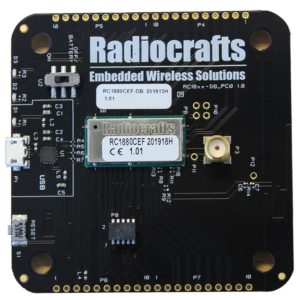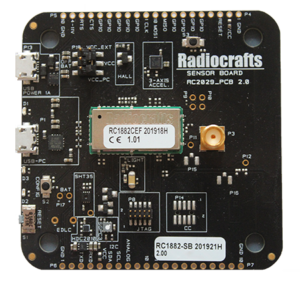Efficient star network at 868 MHz / 915 MHz
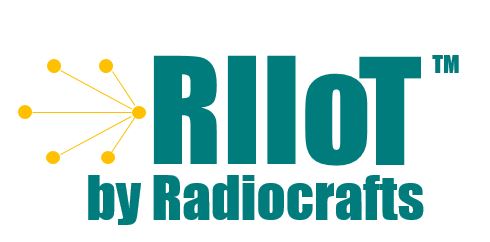
A 2-way symmetric wireless IIoT network supporting long range and very low power.
RIIoT™ (Radiocrafts Industrial Internet of Things) is an RF network designed to be very easy to implement and to meet the sensor and actuator connectivity requirements for the Industrial IoT. The RF protocol is the IEEE802.15.4 g/e standard that supports both 868 MHz and 915 MHz for global applications. RIIoT™ includes an Intelligent C-programmable I/O (i:zi), which makes it possible to directly interface to any sensor or actuator and supports mist computing. RIIoT™ does not require any license or subscription fee.

Global support
The RIIoT™ system consists of the following parts:
- The RIIoT™ Net Controller
- The SPR module, the RIIoT™ leaf node module
- The GPR module, The RIIoT™ gateway module
- The RIIoT gateway dongle, an option to an embedded GPR module for easier implementation
- The RIIoT™ development tools
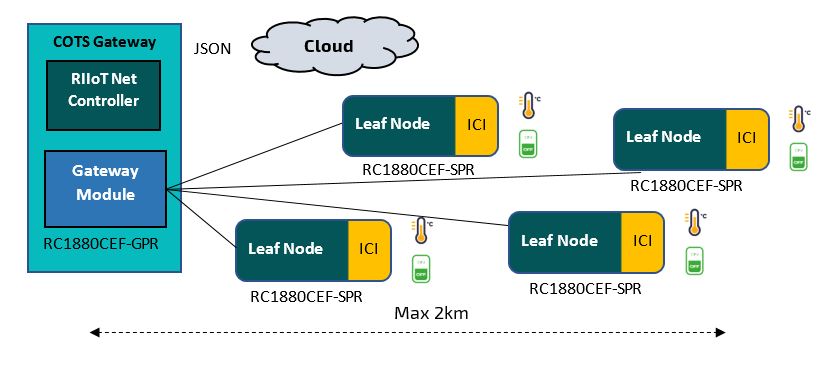

Support for the cloud
RIIoT™ is designed to interface directly to Cloud applications via JSON objects on a socket in the gateway. An example of how to connect to a Cloud application can be found in our Application note, AN028: Connecting Many Sensors to the Cloud in IIoT – RIIoT to Cloud Setup, where Radiocrafts shows you how to connect RIIoT™ to Thingsboard, an open source Cloud platform.
The RIIoT™ Net Controller, the Linux middleware that integrates in a gateway and makes it easy to both manage the RF network and route data to user gateway applications or to the Cloud.
The RIIoT™ Net controller provides a socket interface for user applications, making RIIoT™ compatible with any platform and user application written in any language. Data from RIIoT™ networks are forwarded to user applications as JSON objects that are easily parsed and forwarded to the Cloud.

Long RF range
RIIoT™ RF is based on the IEEE802.15.4g/e standard which is a robust long-range network sufficient for most industrial applications.
Radiocrafts has measured the range of RIIoT™, the details are available in our application note – AN027: RIIoT™ Range – Basics and Measurements Results.
The range is summarized in the table below.
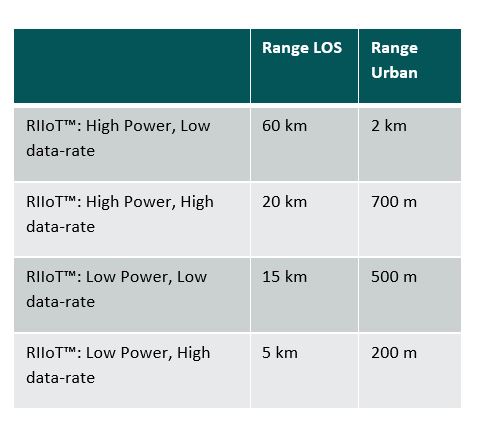

High node count
RIIoT™ networks support a high node count per gateway driven by the short transmit pulse time and the Listen Before Talk (LBT) feature on MAC level. The risk of interference between simultaneously sending nodes is small with short Tx pulses.
Radiocrafts has done tests with RIIoT™ using 28 nodes sending data randomly every 4 seconds to one gateway. We achieved amazing results having 99.83% good packets received. To be fully compliant to the 2.8% rule, we need to reduce the update rate to sending every 5 seconds, that will also decrease the packet loss slightly.

Frequent readings/updates
Frequent Readings/Updates are possible due to the short pulse length in IEEE802.15.4 e/g. This ensures that many messages can be sent during the space of an hour, without violating the maximum duty cycle requirements that are imposed by radio regulations. The RIIoT™ message length (45ms in long range mode) is less than 3% of a LoRaWAN long range message or a Sigfox message.
Long pulse length is a major concern when frequent readings are required in a multi node network, as packet collisions will soon be a problem when the pulse length is long and the node count increases.

Near real time control
RIIoT™ is an excellent network for near real time control applications. RIIoT™ is based on the IEEE 802.15.4 g/e which is a symmetrical wireless communication protocol. The RIIoT™ implementation as a star network means that the delays in the network are short, in the range of 10ms, and predictable. This is ideal for near real time control applications such as manufacturing, environmental control, asset tracking, alarm systems and many more.

Over-the-air (OTA) firmware updates
Your product will be future-proofed by RIIoT™’s over-the-air updates. OTA updates are possible because of RIIoT™’s two-way communication channel and the module’s internal flash memory.
You can upgrade your RIIoT™ nodes in the field with new sensor/actuator interfaces, new mist computing algorithms, and updated security patches. You can also keep the underlying RF system firmware current using RIIoT™ Over-the-Air updates.

Very Low Power
RIIoT™ supports very low power applications. Coin cell or Energy harvesting solutions for the leaf nodes can easily be supported for most sensor/controller applications. The most important technologies behind the very low power consumption are:
- Very low sleep current, 0.7µA with crystal based sleep timer running
- Very short transmit pulses, 4.5mS in 50kbps mode / 45mS in 5kbps mode
- A solution that supports long time intervals between updates and sleep, RIIoT™ has no mandatory background communication and includes transmit intervals that are very flexible to manage, see the ICI section for more details.
The benefits of low power is that it enables wireless solutions (batteries or energy harvesting) and reduces the systems costs (small batteries, no super caps, and it supports low cost energy harvesting)
Radiocrafts performed a test where we ran RIIoT on Solar Energy. You can read about this in the application note, AN031: Running RIIoT on Solar Energy

Advanced Security
AES128-CCM encryption
RIIoT™ secures data in-flight using AES128-CCM, an encryption scheme that offers confidentiality, integrity, and authenticity assurances. AES128-CCM offers protection against eavesdropping, modification, replay, and impersonations.
Unique Key per Link
A unique AES key is established between each node and the coordinator using Elliptic Curve Diffie-Hellman (ECDH). So even if one node is compromised, data from the rest of the network is still secured.
End-to-end security
RIIoT™ users can also opt-in for end-to-end security to encrypt data all the way from the end node to the user cloud application. With end-to-end security, data is protected from eavesdropping or modification even in the gateway that is responsible for routing.
Whitelisted nodes
RIIoT™ users can also use a “whitelist” so only approved nodes are accepted into the network. A whitelist requires a verification of the node’s security credentials prior to it joining the RIIoT™ network.

Interface directly to any sensor or controller
The Intelligent C-programmable I/O (ICI) that is included in the SPR node, comes with APIs to read and write to the local interfaces, including UART, I2C, SPI, GPIO and ADC. The ICI is programmable in high level C. ICI allows the user to integrate to any sensor or actuator or any combination of sensors and actuators directly to the SPR node without any external MCU.

Symmetrical down and uplink communication
The IEEE802.15.4.e/g supports symmetrical communication which means that messages can be sent at full speed both uplink and downlink. Good bi-directional communication is critical for any control application and also for making firmware Over the Air updates (OTA).
Build a RIIoT™ Network
The Leaf Nodes
The leaf nodes are built using the SPR Module. The SPR module is a fully integrated module that only requires power and an antenna. The SPR module will interface directly to any sensor/controller and will easily build into a battery operated sensor box together with the sensor/controllers needed by the system’s designer.
Click here for more details on the SPR module.
The RIIoT™ Gateway
The RIIoT™ gateway is based on the GPR Module and the RIIoT™ Net Controller. The GPR module will accept RIIoT™ RF and transform this to serial data in the gateway or vice versa. This serial data will be accessed by the RIIoT™ Net Controller that will make the data available in JSON format inside the gateway, or JSON data coming in will be transformed to serial data for the GPR module.
The RIIoT™ Net Controller requires a Linux platform that can be found in many commercially available gateways. Please see a selection of options here.
The GPR module can either be integrated in the gateway by the customer or, alternatively, the customer can use the RIIoT gateway dongle that includes a GPR module and can connect to a gateway via USB.
RIIoT™ tools to accelerate your development
The RIIoT SPR SDK
The user will program the SPR modules using the RIIoT SPR SDK to create a flash image for download to the module.
Click here for more details on the RIIoT SPR SDK.
The RIIoT™ Gateway Software Package
The package includes tools and firmware to set-up a RIIoT™ network through the GPR module. The package provides the ability for the user to set up key network parameters to optimize for a specific network’s requirement.
Click here for more details on the RIIoT™ Gateway Software Package.
The RIIoT™ Development Kit
The development kit includes all the hardware needed to start running a small RIIoT™ network from a PC. This allows the customer to test the network capabilities with minimum development resources needed. This is ideal for a first performance test in a customer environment.
Click here for more details on the RIIoT™ Development kit.
RIIoT™ Application Notes
Application Notes to help you setup your RIIoT™ Network.
For more details on the RIIoT™ Parts and Tools click here.
DATA SHEETS AND USER MANUALS
File type: |
File name: |
File description: |
|---|---|---|
Datasheet for the RC1880CEF-SPR leaf node module. |
||
Datasheet for the RC1880CEF-GPR gateway processor module. |
||
User Manual for the RC1880CEF-GPR gateway processor module. |
||
Quick start guide showing how to set up the RIIoT™ Net Controller. |
||
This guide describes the socket API to interface with RIIoT™ Net Controller, a Linux service that interfaces your gateway application to the RIIoT™ RF network. |
APPLICATION NOTES
File type: |
File name: |
File description: |
|---|---|---|
Different applications and different use-cases will need different wireless connectivity technologies. Therefore, selecting the right wireless technology is a critical design decision. Based on radio performance requirements and other criteria, this selection guide will point out the differences between the technologies to help selecting the right one. |
||
This is a short Application Note on the use of license free RF modules in New Zealand, and in particular which modules from Radiocrafts will meet the local radio regulations. |
||
RIIoT has been natively designed to enable cloud connection. The key component in such a solution is the RIIoT IoT gateway. The role of the RIIoT gateway is to connect the RIIoT network with the internet and cloud platforms. There are three dominant and large players in the IoT cloud marketplace: Google Cloud IoT Core, AWS IoT Core, Azure IoT HUB. In this application note, we will show you how to connect your RIIoT network to these 3 cloud solutions. |
||
RIIoT requires a gateway to collect data from sensors, to process the sensor data and to send data to the end application (e.g. in the cloud/a screen etc.). There are a number of use cases and business cases around RIIoT, and the requirements for gateways differ from one application to another. Thus, there is no one single gateway solution that fits all use case. We will discuss the different gateway options in this applciation note. |
||
To prove that RIIoT supports one of the most critical features of IoT, i.e., very low-power consumption, we removed all traditional power-sources from a RIIoT board and connected it to a solar panel. The result obtained is that in normal office-lighting conditions, with a 53 x 25 mm solar cell, a RIIoT leaf node can read sensors and send data to the gateway every 30 seconds. |
||
This application note demonstrates how easy it is to create your own application using Radiocrafts’ ICI (intelligent C-programmable I/O). |
||
This application note demonstrates how to setup a commercial off-the-shelf (COTS) gateway for RIIoT™, and how to integrate it with an easy-to-use IoT cloud service provider. |
||
Learn everything you need to know about understanding range from LoS to antenna design and more. Also read about the impressive RIIoT™ range measurements conducted by Radiocrafts both in urban and LoS areas. |
||
There are many different wireless standards and technologies available to enable the internet of things (IoT). The different technologies have different pro’s and con’s depending on the use case and the end customer. Trying to keep up with the latest wireless trends can drain a company of all its resources and take attention from its core business. The solution recommended by Radiocrafts is to use a modular approach and a common RF module footprint that enables all the technologies offered by Radiocrafts without modifications to the PCB. |
||
When selecting the right radio technology, the achievable communication range is an important factor. This document reviews how to analyse radio range based on parameters provided in the datasheets for the different module families. Some measurement results from practical range testing are also shown. |
The RIIoT™ development kit includes three boards with antennas, power supplies, and a USB cable for PC connection.
- A RIIoT™ Gateway Board, a development board with a GPR Module
- A RIIoT™ Leaf Node Board, a development board with an SPR Module
- A RIIoT™ Sensor Board, a board with an SPR Module and 7 industrial sensors.
- RC1880-RIIOT-DK, for regular power networks
- RC1880HP-RIIOT-DK, for high power 868 MHz networks
- RC1890HP-RIIOT-DK, for high power 915 MHz networks
SOFTWARE TOOLS AND REFEENCE DESIGNS
File type: |
File name: |
File description: |
|---|---|---|
RIIoT SPR SDK, the software development kit to build custom applications on SPR modules. |
||
The RIIoT™ Gateway Software Package includes tools and firmware to set-up a RIIoT™ network with the GPR Module and a standard Linux based gateway. The ambition is to make the set-up process as easy as possible, while still maintaining the ability for the user to set up key network parameters to optimize for a specific network’s requirement. |
||
This is the second revision of the Sensor Board. Schematic and PCB documentation used for our development kits. This board is recommended to use as a reference design. |
||
Schematic and PCB documentation used for the development board. This board is recommended to use as a reference design. |
DEVELOPMENT KIT AND SOFTWARE TOOL DOCUMENTATION
File type: |
File name: |
File description: |
|---|---|---|
This User Manual contains the RIIoT™ DK quick start and describes how to use the Development Kit for RIIoT™ modules. |
||
RIIoT™ Quick start guide showing how to develop an application on the SPR module using the Intelligent C-programmable I/O (i:zi). |
||
User manual for developing applications on the SPR module using the Intelligent C-programmable I/O (i:zi). |
||
Tutorial showing how to develop a simple application on the SPR module using the Intelligent C-programmable I/O (i:zi): Button, LED and Timer. |
||
Tutorial showing how to develop a simple application on the SPR module using the Intelligent C-programmable I/O (i:zi): Send Periodic Network Data. |

For any module inquiries please contact our local partner.
Or buy online at Digikey.com
Product Name | Frequency | Region/Compliance | Buy Module Online | Buy Development Kit Online |
RC1880CEF-SPR | 868/915 MHz | EU/US | ||
RC1880CEF-SPR | 868/915 MHz | EU/US | ||
RC1880HPCF-SPR | 868 MHz | EU | ||
RC1880HPCF-GPR | 868 MHz | EU | ||
RC1890HPCF-SPR | 915 MHz | US | ||
RC1890HPCF-GPR | 915 MHz | US |








